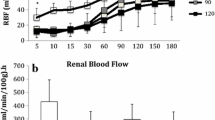Summary
Dog kidneys were hypothermic perfused with canine or human plasma up to 72 hrs and then transplanted. Samples were taken regularly from the perfusate and lactate and pyruvate were measured. A characteristic behaviour of the lactate/pyruvate ratio, not corresponding with the viability of the kidneys, was seen in all experiments: after decreasing in the first 20 hrs of perfusion the lactate/pyruvate quotient gradually rose. Kidneys perfused insufficiently with oxygen (pO2 less than 80 mm Hg) showed high quotients. Besides the lactate/ pyruvate ratio was tested depending on the pH. Varying the oxygen tensions between 140 and 400 mm Hg and the pH between 7.0 and 7.8 didn't influence the viability of the kidneys. The rising of the lactate/pyruvate ratio after 20–24 hrs is explained with the accumulation of toxic products in the perfusate; exchanging the perfusate at this time is proposed to improve the results of kidney preservation.
Zusammenfassung
Hundenieren wurden bis zu 72 Std hypotherm mit Hundebzw. Humanplasma perfundiert und anschließend reimplantiert. In regelmäßigen Abständen wurden Perfusatproben entnommen und Lactat und Pyruvat gemessen. In allen Versuchen konnte ein charakteristischer Verlauf des Lactat/Pyruvat-Quotienten beobachtet werden, der nicht mit der Vitalität der Nieren korrelierte: einem Abfall des Quotienten in den ersten 20 Std der Perfusion folgte ein allmählicher Anstieg. Nieren, die mit ungenügenden Sauerstoffspannungen (pO2 unter 80 mm Hg) perfundiert worden waren, zeigten hohe Quotienten. Außerdem wurde die pH-Abhängigkeit des Lactat/Pyruvat-Quotienten geprüft. Sauerstoffspannungen zwischen 140 und 400 mm Hg und ein pH zwischen 7,0 und 7,8 beeinflußten nicht die Vitalität der Nieren. Der Anstieg des Lactat/Pyruvat-Quotienten nach 20–24 Std wird mit der Anhäufung von Toxinen im Perfusat erklärt; es wird vorgeschlagen, das Perfusat zu diesem Zeitpunkt auszuwechseln, um die Konservierungsergebnisse zu verbessern.
Similar content being viewed by others
Literatur
Alexander, J. L., Dmochowski, J. R., Murray, J. E., Couch, N. P.: Successful 24 hour renal perfusion-preservation with monitoring by surface electrometry during the storage interval. Surgery67, 944 (1970).
Belzer, F. O., Ashby, B. S., Dunphy, J. E.: 24-hour and 72-hour preservation of canine kidneys. Lancet1967 II, 536.
Belzer, F. O., Kountz, S. L.: Preservation and transplantation of human cadaver kidneys. Ann. Surg.172, 394 (1970).
Cooperman, A. M., McIlrath, D. C., Holley, K. E., Maher, F. T.: Successful 24 hour preservation of canine kidneys. Surgery70, 399 (1971).
Diskussion in: Workshop on organ preservation. Report of meeting. Surgery69, 321 (1971).
Duke, H. N.: An adverse effect of polyvinylchloride tubing used in extracorporeal circulation. Lancet1968 II, 21.
Grundmann, R., Liebau, G., Pichlmaier, H.: Stoffwechseluntersuchungen an hypotherm perfundierten Hundenieren. Langenbecks Arch., Suppl. Chir. Forum 107 (1972).
Hohorst, H. J.: In: H. U. Bergmeyer. Methoden der enzymatischen Analyse, 1. Aufl., S. 266. Weinheim: Chemie Verlag 1962.
Huckabee, W. E.: Relationships of pyruvate and lactate during anaerobic metabolism. J. clin. Invest.37, 244 (1958).
Kiser, W. S., Magnusson, M. O., McLaughlin, T. C., Hewitt, C. B., Straffon, R. A.: Preservation of human cadaver kidneys for transplantation. J. Urol. (Baltimore)105, 779 (1971).
Liebau, G., Klose, H. J., Fischbach, H., Pichlmaier H.: Simple tests for viability of hypothermic pulsatile perfused dog kidney. Surgery70, 459 (1971).
Liebau, G., Grundmann, R., Pichlmaier, H.: Vitalitätskriterien isoliert perfundierter Hundenieren. Langenbecks Arch.329, 976 (1971).
Lokkegaard, H., Gyrd-Hansen, N., Hansen, R. I., Hasselager, E., Nerstrom, B., Rasmussen, F.: Kidney preservation with pulsatile and non-pulsatile hypothermic serum perfusion. Acta med. scand.188, 245 (1970).
Persidsky, M.: Lysosomes as primary targets of cryoinjury. Cryobiology8, 482 (1971).
Persidsky, M., Ellett, M. H.: Lysosomes and cell cryoinjury. Cryobiology8, 345 (1971).
Author information
Authors and Affiliations
Additional information
Mit Unterstützung des Sonderforschungsbereichs 37 der Universität München.
Rights and permissions
About this article
Cite this article
Grundmann, R., Liebau, G., Wurzer, H. et al. Hypotherme pulsatile Perfusion von Hundenieren. Res. Exp. Med. 158, 211–218 (1972). https://doi.org/10.1007/BF01852312
Received:
Issue Date:
DOI: https://doi.org/10.1007/BF01852312




